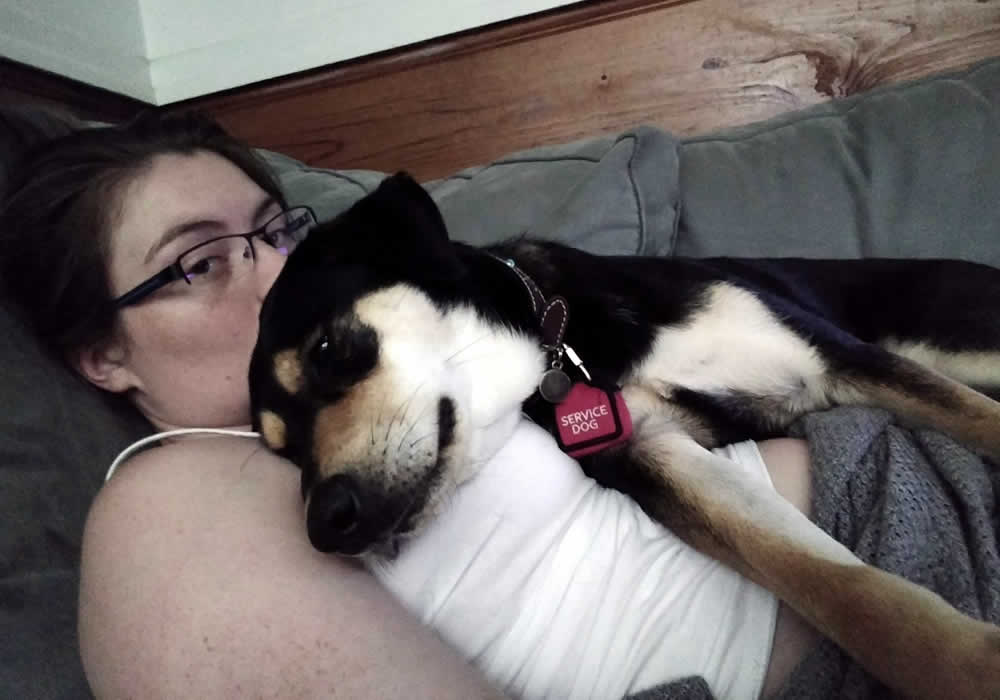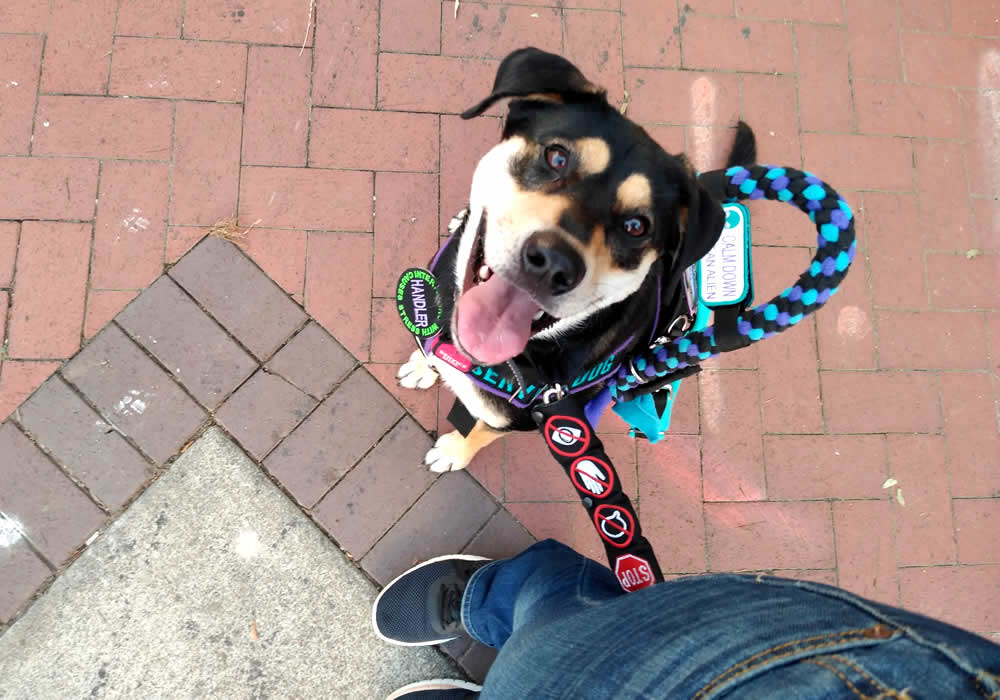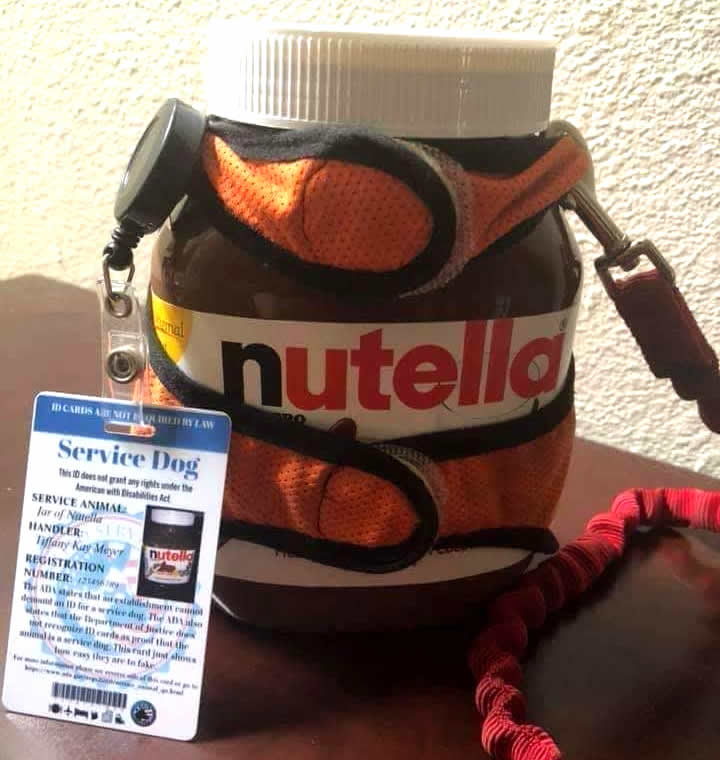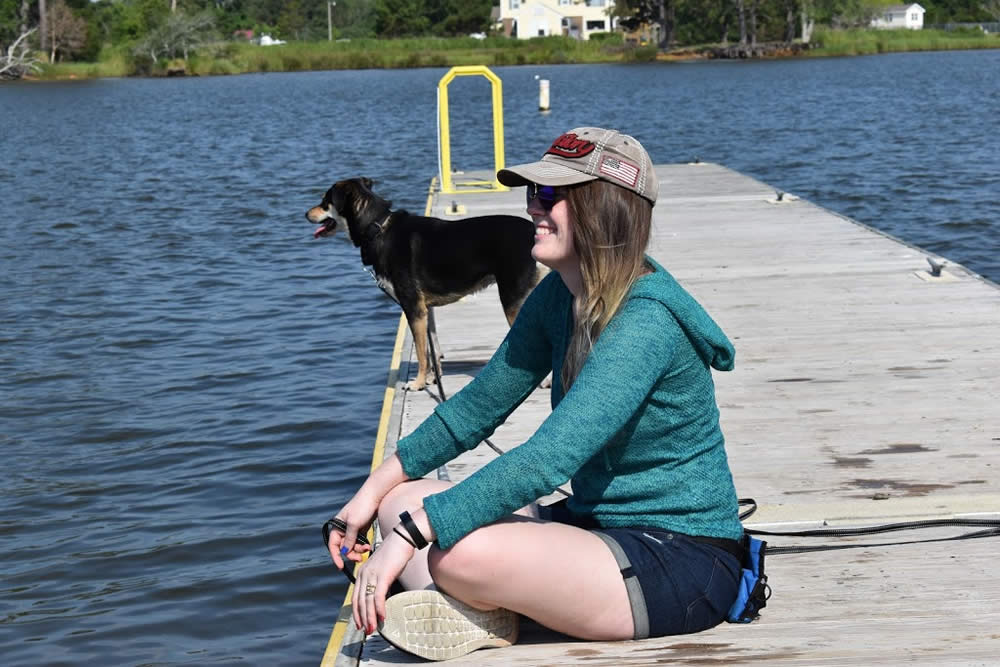It's Thursday April 25, 2024
News From The Village Updated Almost Daily

August 9, 2019
Growing up spending my summers in Oriental, I’ve always known the town to be both full of boats and dogs alike. As a little girl, I wanted to befriend every dog and I knew all their names (often, better than I did their humans).Now that I’m a little older, I’ve learned that not every dog wants attention and not every dog should get attention. Having a service dog – and a cute one, at that – I see all of those young kids just like me when I was younger whose eyes light up and brains start going “Ooooo! Puppy!” and rush over to pet. However, that’s not okay because my dog is working and needs to be focused on me.
All brushed and dressed up before the CroakerFest paradeService Dog – A DefinitionFirst, forget everything you think you know about service dogs. The media often misrepresents them and often don’t truly understand the terms they’re using. Under federal law (specifically, the Americans with Disabilities Act of 1990), a service animal is a dog or miniature horse who has been trained to perform work or tasks that mitigate their handler’s disability. These animals are legally considered medical equipment, and can go with their handler anywhere the public is legally allowed (with some exceptions for sterile environments or religious buildings.)Service animals do not have any legally recognized ID cards, certifications, or registries out there. You may have seen sites stating that, if you want to take your dog everywhere, you must register with their site (pay an exorbitant fee) and will receive an ID card, a vest, and a certificate. That all means absolutely nothing. Those sites are scams, and say in fine print that they are not legally recognized.
What makes a dog a service dog is countless hours of training (usually at least two years, sometimes more) to learn how to behave in any environment and how to mitigate their handler’s disability. A few common examples of things service dogs do include seizure alert/response, guiding the blind/visually impaired, or helping pull wheelchairs, but there are so many other things that they can do.
Service dogs help with many different disabilities, including epilepsy, mobility issues, PTSD, severe allergies, blood sugar or circulation issues, cardiac troubles, and many more.
Delilah, my service dog, is considered a multipurpose service dog, meaning that she helps me with a few disabilities that I have. She has learned to press buttons for crosswalks and handicap doors, alert to changes in my breathing, and provide deep pressure therapy to lessen my anxiety or panic attacks. Currently we’re working on guiding me to building exits, leading me to my car in a parking lot, and cortisol alerts, yet our to-do list after these is still extensive. For examples of our training, we post weekly training videos showing what we do on our YouTube channel. Check out DelilahTheServiceDoggo.
This is a task called “Deep Pressure Therapy” or DPT where she will put her weight on me to help ease or even stop a panic or anxiety attack from happening by causing a shift from the sympathetic nervous system to the parasympathetic nervous system.Distracting these hard-working dogs can lead to major medical events, including hospitalization or worse, for the handler that the dog could have easily prevented had they not been interfered with. Distractions can be anything from petting them, talking to them, making kissy noises, eye contact with them, and more.
The best thing you can do for teams is completely ignore the dog. I am still training my dog to ignore everyone and everything around us, but it hurts her training when people rush up to us or stare at her.
Did you know that eye contact with dogs is aggressive to them? Relatedly, have you ever sat at a red light feeling like you were being watched and it put you off? It’s a big distraction to humans, but exponentially worse to dogs. Another big distraction would be untrained pets where they’re not supposed to be. They often bark which is distracting but worse still, they can be aggressive and attack service animals, handlers, or even members of the public. Fake service dogs are a big problem that comes with a big fine.
Regardless of how well trained your dog may be, don’t bring your dog somewhere they aren’t supposed to be.
Despite being clearly labeled with “DO NOT PET” in large letters down her sides, you’d be surprised how often people stop us to ask to pet her.Most of my disabilities come from mental illnesses and, while my disabilities are psychiatric in nature, they are still disabilities that my service animal can mitigate. Because there are tasks that my dog does for me to mitigate the symptoms and effects of my disabilities, she is a psychiatric service animal and not an emotional support animal.
Emotional support animals are completely different from service dogs in that they’re untrained pets and can be any species. They are still prescribed by a medical team and do still help people with disabilities, but only by function of being an animal. Things like cuddling/comforting you when sad or motivating you to get out of bed in the morning can be very beneficial for people with disabilities but aren’t tasks because that’s just the nature of a pet. As such, Emotional Support Animals aren’t considered medical equipment and aren’t allowed to go into no-pet businesses. The only rights that emotional support animals have that are beyond those of basic pets are living in no-pet housing (or without fees/deposits in pet-friendly housing, described in the Fair Housing Act) or flying in the cabin of an aircraft with their handler (courtesy of the Air Carrier Access Act).
Under my chair and out of the way at Toucan Bar & GrillSpeaking of businesses, gatekeepers are only allowed to ask two questions of anyone entering the establishment with an animal:
(1) Is that a service animal required for a disability?
(2) What work or task is the animal trained to perform?
If the person answers the first question with anything other than “yes” or “yes, in training”, they can be denied entry as North Carolina state laws protect service animals training in public spaces. If the person answers the second question with anything like “emotional support,” “comfort,” or “protection,” those aren’t considered tasks and the animal can be denied on those grounds.Also, if they show you an ID, don’t take that as an answer to both questions.
Below is a photo of a registered “service dog” with an ID, just to prove a point that ID’s mean nothing. Please be mindful that you can’t ask for any papers or proof (there’s no legal documentation, anyway, as mentioned earlier), you can’t ask about the person’s disability (that’s just rude – you wouldn’t ask a stranger about what they discuss with their doctor, after all), and they aren’t required to be vested or marked in any way (sometimes vests are difficult to use with various disabilities).
Yes, someone registered and got a “Service Dog” ID card for a jar of Nutella. I’ve seen others with cartoon characters, stuffed animals, other foods, and even celebrities.Any animal in an establishment that is out of the handler’s control or causing concern to the health and safety of others may be asked to leave, even if it’s a service animal. Examples would include barking a lot without provocation, relieving itself in the establishment, or displaying aggressive behavior.
Service animals are not robots and should not be expected to behave as such. However, they are held to high standards. In a restaurant, a true service animal would be sitting or lying quietly next to their handler or under the table or chair and would never ever be in a chair at a restaurant or eating anything from or that was on the table. The ideal for service animals is that you don’t even know they’re there.
Delilah is sitting quietly and very focused on me and my needs, completely ignoring the sailing meeting going on around her.Finally, please educate your children or the kids in your life to give dogs space and always ask first before even approaching an animal they don’t know, much less, reaching to pet them. Also, when reaching to pet a dog, avoid eye contact and reach under their chin rather than over their heads as it’s less threatening.
Taking time to just be a dog after CroakerFestIf you have any questions beyond this information, please feel free to reach out. I have an email set up for service animal education at DelilahTheServiceDoggo@gmail.com. The more people who know about service animals, the safer it is for us, and other service dog teams, to leave our homes.
Related LinksMcKenna Williams lives in Raleigh but has been coming to Oriental most her life, participating in youth and NC State sailing programs. She sneaks back every chance she can.
McKenna Williams took time from her service dog training to write this for International Assistance Dog Week. McKenna is passionate about service animals and disability advocacy.







